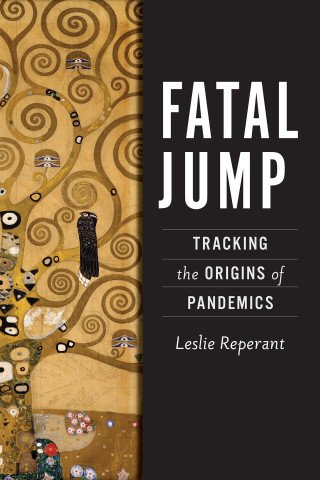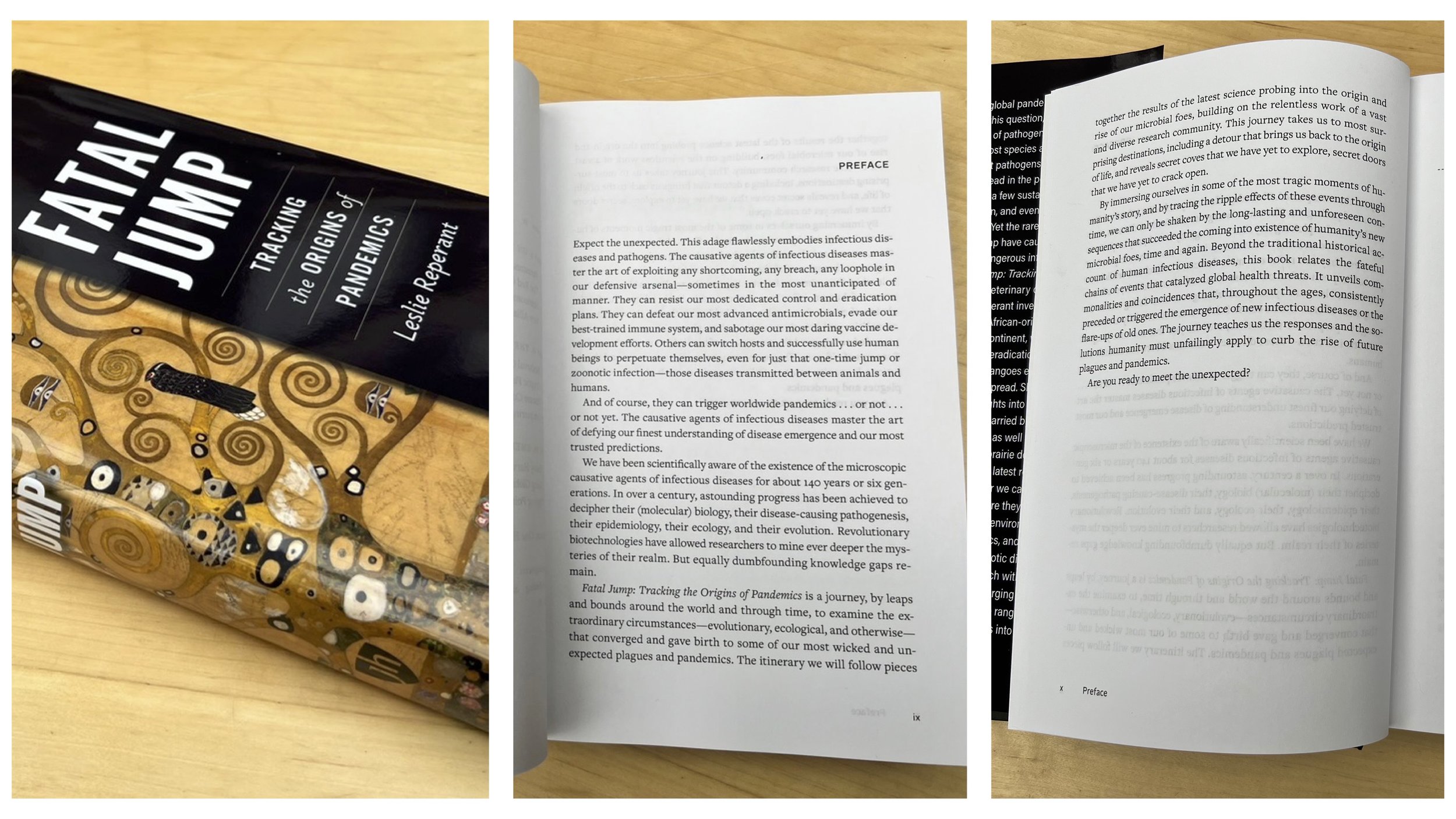FATAL JUMP
Tracking the Origins of Pandemics
21 March 2023 | ISBN: 9781421446363
Written by veterinary disease ecologist Leslie Reperant and published by Johns Hopkins University Press.
The pace of disease emergence is accelerating. Beyond the traditional historical account of human infectious diseases, Fatal Jump: Tracking the Origins of Pandemics unveils commonalities and coincidences that, throughout the ages, consistently preceded or triggered the emergence of new infectious diseases or the flare-ups of old ones. The journey teaches us the One Health responses and solutions humanity must unfailingly apply to curb the rise of future plagues and pandemics.
Read a few excerpts at the end of the page.
One Health Day | 3rd November | READERS’ ENDORSEMENTS
-
Thoroughly-researched and beautifully written, Fatal Jump takes you on a journey through time as it explores the tangled journey of our species and the many pathogens that have plagued us, and those that may yet do so in the near future. Combining rigorous science with a storyteller’s flair, Leslie Reperant retraces the origins of zoonotic diseases, reveals the circumstances leading to host jumps and sometimes pandemics, and identifies other pathogens lurking in the wild as potential threats to humanity. A real epidemiological page-turner!
-
A useful reminder and an expanded education for the specialists and important insights and truths for the wary general public and political leaders.
-
Dr Reperant has meticulously crafted an eloquent and comprehensive account of the history, evolution and emergence of infectious diseases. The narrative draws us into a fascinating journey that starts with the earliest fossilised parasites, tracing the epidemiological transitions brought about by animal domestication, human conquest and colonialisation, and culminating in a thoughtful exploration of contemporary drivers of epidemic threats.
The book is beautifully written and a genuine pleasure to read, infused with intriguing insights and providing clear and concise explanations. There is something new for everyone and I would consider the book indispensable for students of disease ecology - a ‘must-read’. It is a wonderful achievement that combines accessibility with high-quality scholarship.
-
This is an excellent book that thoroughly covers the evolution of living organisms in a straightforward and logical manner. This provides an excellent backdrop to the later coverage of pandemics, not only providing an insight into their origins but also a picture of where things might go in the future. A must read for both new and accomplished epidemiologists and virologists!
-
Leslie Reperant has written a wonderfully clear exposition describing the complex interactions between pathogens and their hosts, and the evolution and emergence of pathogens through the ages. She has been able to integrate the separate threads from different fields and disciplines into a cogent and compelling narrative that extends from historical plagues to the current situation and knowledge as well as our increasing concerns about the importance of human activities that affect global ecology and the increasing incidence of disease emergence.
Her insights and commentary clearly demonstrate her depth of knowledge and understanding of the often highly intricate ecological, phylogenetics and epidemiological relationships. With most pandemics having an animal origin, the importance of zoonoses is a recurring message in the book, and is a testament to the importance of a One Health approach in understanding and responding to zoonotic diseases. It is a must read for anyone interested in infectious diseases, epidemiology, ecology and in the history and origin of pandemics.
The enormity of the scope of the book is really dazzling!
-
A most enjoyable and well written book in which the author uses her excellent insights and deep scientific knowledge to give us an enjoyable ride through the history of our relationship with pathogens and parasites. We pass through one fascinating story after another until she brings us to the current pandemic and the sad but inevitable truth that this will happen again unless serious action is taken. She ends by showing us that this solution lies with One Health, an approach that identifies spillover as an ecological issue that revolves around the interaction of people and their domestic animals.
-
Probably the most comprehensive recent review on the natural history and ecology of human infectious and parasitic diseases. Leslie Reperant takes the reader from the Paleolithic to the beginning of the 21st century. Her investigations in the scientific literature cover the relationships of animals, humans, microbes and parasites on all continents. We can no longer say that we didn't know...
-
It is part of our human nature to want to know where things come from — where the world comes from, where the plants and animals around us come from, where humans come from and so forth. Every human culture on Earth has a narrative for how everything began and where things come from. The question of where infectious diseases come from is not typiclly part of classical narratives because we have only understood the basics of infections for about 100 years. The origins and spread of diseases was never more interesting or important than now, as the world recovers from the Covid pandemic that turned our day to day life upside down and took so many from our midst. But Covid is just one outbreak among scores that have occurred during human existence. It was horrible and touched everyone’s life in one way or another. But it could have been worse. It could have spread faster and it could have been deadlier. What could be worse than Covid? I’ll give an example. A few months before the pandemic, I was travelling with my family in the tropics and within a week after we returned, one member fell ill with fever that rapidly got worse. We went to a state of the art clinic specially designed for such cases where things did not however improve. With the family member close to coma, the doctor on night watch came in smiling and said “We have good news, its not Ebola, Marburg, or Lassa.“ Those three viruses are far worse than Covid-19, which at that time was not even known. What are Ebola, Marburg and Lassa, where did they come from and how do we even know about their existence? Leslie Reperant gives you vivid and expert answers to those questions in her book. But not just that. In Leslie’s book, you can find the succinct history of almost every infectious disease (diseases caused by bacteria and viruses) of humans, factual accounts of the initial cases that brought the disease to the attention of doctors and — here comes the scary part — information about which animals harboured the agents of the disease before it mutated and made the jump to humans. Fatal jump is rightly titled. Humans have always been under siege of pathogens, and our modern mobility makes us easier targets than ever before. What should we do? Leslie has suggestions. And the disease that my family member had? It turned out not to be a virus after all but a rare and often deadly bacterium that is readily treated with expertly chosen antibiotics, which brought full recovery within 24 hours. We are deeply thankful. Where that bacterium came from and how it spread to humans and my family, I should know because I am a biologist well versed in such things. I do know now, thanks to Leslie’s book which is a great read and has an outstanding index.
-
This book is the new "go to" reference for zoonotic infectious diseases. Going back through the millenia, Reperant provides the most comprehensive overview of the fantastical histories of several pathogen classes: not only the RNA virus behind COVID-19, but several RNA viruses, as well as DNA viruses, bacteria and parasites - each in extraordinary detail and depth. Whilst other infectious disease books have scientist-centered accounts and personal takes on scientific findings, Reperant focuses on the microbes and pathogens themselves and the studies behind them, following the microbes spillover to new hosts. She describes their migratory paths across continents and, in some mysterious ancient cases, oceans. Reperant aptly explains cospeciation and in-host speciation, using easy-to-understand and page-turning language. She allows the reader to engage as an eager student and admits when some mysteries remain unresolved, whether it's the trajectory of competing strains or even by which route filoviruses truly transmit so well. I highly recommend Reperant's book, which is packed with such useful information for experts as well as anyone interested in epidemiology, virology, and infectious diseases.
-
Fatal Jump is a timely synthesis on emerging infectious diseases in this Pandemic Era. In 11 chapters, Leslie Reperant traces the co-evolution of pathogens and hosts from the fossilized remains of a mosquito embedded in amber to the live animal markets in South-East Asia, where COVID-19 emerged. Skilled both as a writer and a scientist, Dr Reperant not only describes the origins of pandemics, she also explains why the current economic system is accelerating the pace of disease emergence, and shows how we can get out of this new pattern of so-called “Mad Hatter” evolution. A fascinating read.
Table of Contents
Preface
Part I: On the Origin of Plagues
1. Parasites, Pathogens & the Tree of Life
2. The Red Queen & the Court Jester
3. Heirlooms & Souvenirs
4. New Alliances & Painful Scars
Part II: The Ghosts of Plagues Past
5. Medieval Outcasts
6. Cryptic Plagues
7. Disease Conquests
8. Conquering Diseases
Part III: Emergence
9. Heavy Harvests
10. Going Global
11. Tipping Points
Epilogue: One Health and the Mad Hatter
Acknowledgements
Bibliography
Exploring the fateful chains of events that gave rise to humanity's infectious diseases and pandemics.
Why do global pandemics like COVID-19 materialize? To address this question, we must dive into the world of pathogens that transcend their original host species and jump into new ones. Upon attempts to jump into new species, most pathogens fail to initiate infection or spread in the population. Only a few sustain onward chains of transmission, and even fewer sustain these indefinitely. Yet such fatal jumps have been at the origin of many of humanity's most dangerous infectious diseases.
In Fatal Jump: Tracking the Origins of Pandemics, Dr. Leslie Reperant analyzes the circumstances that have ignited the surge of new pathogens in humans. From the often-overlooked but crucial point of view of a veterinary disease ecologist, Reperant investigates mysteries such as how African-originated monkeypox left its home continent and shares behind-the-scenes insights into hugely destructive pathogens spread by ticks and mosquitos. Drawing from the latest science, she discusses whether we can predict these deadly jumps before they happen and what factors—environmental change, population dynamics, and molecular evolution—enable a pathogen to reach full pandemic status. Rich with recent scientific discoveries and emerging theories, this book spans a vast and diverse range of disciplines and weaves these insights into a holistic view of emerging infectious diseases.
With new pathogens emerging at an ever-increasing pace, Fatal Jump reorients our perspective on infectious diseases and pandemics from the human-centered standpoint to the bigger picture. Only by recognizing the increasingly global nature of human society, and the connections between our planet's environmental health and our own health, will we understand what actions are necessary to reverse this trend.
This book is a journey, by leaps and bounds around the world and through time, to examine the extraordinary circumstances—evolutionary, ecological, and otherwise—that converged and gave birth to some of our most wicked and unexpected plagues and pandemics.
— Leslie Reperant, author
Reviews
An essential one-stop shop for all you need to know about the evolution and emergence of infectious diseases. Reperant gives us a comprehensive, compelling and beautifully written account of the origin of epidemics, seamlessly combing data from the evolutionary, ecological, and genomic fields. A truly remarkable achievement.
— Edward Holmes, University of Sydney
In this her first book, Leslie Reperant has answered the question of the source of infections that sicken and cause death in humans by meticulously describing the origin of infection-causing organisms and their manipulative and unpredictable behaviour in hosts ranging from ants and grasshoppers to wild and domestic animals, and humans. A masterpiece of research and writing, and a must read for anyone who has ever wondered about the origins of infectious diseases.
— David L. Heymann. MD. London School of Hygiene and Tropical Medicine and editor, Control of Communicable Diseases Manual
Leslie Reperant's book eloquently brings together threads from many different areas of biology, epidemiology, and veterinary science. She creates a marvelous tapestry illustrating how pathogens, emerge, establish, and spread in host populations. There are new insights in here that are fundamental to our understanding of how pathogens impact the health of individuals and the populations they live in. Ecologists, epidemiologists, and veterinarians will all learn something new from Dr. Reperant's insightful and multi-layered perspective. This book is also a first-class introductory ticket to understanding disease for economists and politicians.
— Andy Dobson, Princeton University
Perhaps the most encyclopaedic book yet about why diseases have always plagued humanity, and why so many new ones are emerging. The tale ranges from how infection among the earliest living things shaped life on Earth – including us – to how the evolutionary war between germs and their victims moulded our past, and threatens our future. Above all, it shows why Covid was no surprise, and why, unless we make some big changes, more pandemics like it – or worse – are coming.
— Debora MacKenzie, journalist, author of Stopping the Next Pandemic: How Covid-19 can help us save humanity
An intriguing account of the complex interaction between pathogens and us, through deep history to now and COVID-19. The narrative probes issues to do with evolution, discusses our defence mechanisms and looks at how viruses in particular jump from other warm-blooded vertebrates into us. This is an easy, informative, and interesting read.
— Nobel Laureate Peter Doherty, University of Melbourne and author of An Insider’s Plague Year
Read excerpts below:
Read the Preface
"Open the book to page ninety-nine and read, and the quality of the whole will be revealed to you." — Ford Madox Ford
Featured Author and excerpt at Princeton Alumni Weekly.
Excerpt at the Scientific Inquirer.
68th episode in Science History Podcast.
A spin-out article in Vector-Borne and Zoonotic Diseases: Putative 14th century outbreak of foodborne Chagas disease in Mexico.
Review in Nature Ecology and Evolution.
Review in The Lancet Infectious Diseases.
Review in The Journal of Medical Regulation
Five Questions & Answers
Why did you focus on illuminating the circumstances that give birth to new infectious diseases and pandemics in humans?
For decades, many groups of experts have voiced recommendations to prevent, prepare and respond to future pandemics: after the aborted pandemic of SARS in 2003, after the influenza pandemic in 2009, after the devastating Ebola epidemic in 2016, and again presently, in the wake of the COVID-19 pandemic. These recommendations have—so far—rarely been heeded; this is disheartening. More and more, experts voice the need for a One Health approach, meaning that protecting public health from future pandemics requires better care for the health of animals, domestic and wild, and for the environment they live in. Unfortunately, One Health actions often are outlined in rather vague and unactionable terms. I believe these difficulties emerge from the much human-centered and medical perspective that is typically applied to the threat of infectious diseases and pandemics—a needed perspective but a cripplingly limited one. By focusing on the circumstances surrounding the rise of new infectious diseases and pandemics in humans, I invite the reader to take a step back and look at pathogens through an all-embracing glance exploring their ecological and evolutionary “raison d’être” in the grand scheme of life, and along the development of the human species, and of human societies. Why do some pathogens jump and invade new host species? Why do they cause acute and virulent diseases? How can we prevent that? Answering these questions requires a solid understanding of disease (or rather pathogen) ecology and evolution.
In your quest to trace back the origins of past pandemics and epidemics, what were some of your favorite stories or discoveries?
There are many parts of the book that I did not plan on writing. Question marks on the margin of my investigations turned into quests. And the quests sometimes turned into dead-ends, and sometimes into cool stories (in my opinion). That’s how the entire Chapter 5 Cryptic Plagues earned its place in the book. In this chapter, I attempt at tracing the rise of severe infectious diseases in Pre-Columbian America (a subject desperately little known and little investigated). Many of my favorite discoveries (and hypotheses) are in this chapter. One of these discoveries is the sudden realization that a 16th century account of a brutal plague among 14th century inhabitants of a trading center near Lake Texcoco in Mexico likely was an outbreak of Chagas disease (a vector-borne disease caused by a trypanosome in Central and South America). Another one of my favorite stories is included in a later chapter, and also involves trypanosomes. It recounts how some of the trypanosomes that can beget the agents of sleeping sickness evolved to ditch the tsetse fly vector and spread around the world (in animals). Theoretically, such an evolutionary path could beget a world-spreading trypanosome—causing a disease akin to sleeping sickness—in humans.
What future insights from research in the field of emerging infectious diseases are you looking forward to? What in your view are the most important unsolved questions?
The recovery of ancient DNA, metagenomics, and the field of phylogenetics (building the family trees of species and groups of species based on genomic sequences) are fascinating to me. They help decipher the evolutionary journey of pathogens (and host species) through millions and millions of years (if not more!). They showcase the jumps that happened in the distant past among radically different groups of host species, or more recent ones between animals and humans. I am looking forward to the discovery of pathogen genomic sequences (in distantly related species or in ancient animal or human remains) that will at once resolve the origins of some of humanity’s infectious diseases which debuts remain utterly mysterious, like hepatitis B, treponemal diseases, mumps and rubella, and others. Another unsolved riddle concerns the factors or attributes that allow a once zoonotic pathogen to sustainably spread from human to human. For most if not all pathogens that managed this feat, these attributes remain stubbornly hidden inside the black box that researchers call transmissibility. If we are to crack this box, we’ll need to make sure we use safe, biosecure techniques.
What are the pathogens that frighten you the most for their potential to trigger a pandemic or large epidemics?
At the moment, I am most frightened by the global pandemic of H5 influenza viruses ravaging wild and domestic bird populations across most continents; this has never happened before. These viruses are increasingly found in diverse mammals, which get the infection from birds. Some of these viruses have spread from host to host in mammalian populations (for example in minks and in seals). The risk that one of these viruses evolves into a human-adapted one is high. I am also much concerned about the mpox (formerly monkeypox) virus, which may be on its way to establishing in the human population and may in time impose heavy burdens on children, especially in the developing world. The environmental changes that may have spurred the emergence of this particular mpox variant in Nigeria before it spread globally may be affecting Lassa virus (a frightening agent of hemorrhagic disease) in a similar way, perhaps with similar global consequences waiting to happen. Nipah virus (which causes infection of the brain and can spread via the respiratory route) is always in the back of my mind. And although directly transmitted viruses tend to be front and foremost in risk assessments of future pandemic threats, I would not underestimate the menace posed by multidrug resistant bacteria, or by the incredibly diverseBorrelia (causing Lyme disease and relapsing fever) and Rickettsia (causing spotted fevers and typhus), or by obscure mosquito-borne flaviviruses (cousins of yellow fever, dengue, and Zika viruses), or by other neglected or yet unknown pathogens... There is no lack for candidates!
How do the lessons learned from your investigations help inform the best responses to future pandemics?
I hope that learning about the (often unexpected) debuts of new infectious diseases in humans and the far-reaching and long-lasting ripple effects they have on human societies and human health (including COVID-19!) will convince the reader of the need for strong and immediate responses upon the emergence of a new pandemic to crush it. By crushing it, I mean to eliminate the emerging pathogen from the human population. To categorically thwart its attempt at establishing in humans. Although many societal factors come into play, elimination is not an impossible goal (as is known in the veterinary services). In the end, we will always fare better making the concerted efforts to crush it than “learning to live with it”. I also hope that the book’s ecological and evolutionary perspective will help foster actionable and concrete (and bold) One Health interventions to prevent future pandemics by preventing fatal jumps in the first place. Most remarkably, such One Health interventions have the potential to concurrently address biodiversity loss, ecosystem degradation, climate change, animal welfare, and societal inequities.
Behind the (Book Writing) Scene
What audience is Fatal Jump targeting?
Fatal Jump’s ambition is to reach a broad audience, the general public, policy makers, but to remain relevant and riveting even for the greatest experts in the field of infectious diseases. Achieving this can be quite challenging. I tried and used a conversational tone and filled the pages with stories taking the reader to different times and different places to explore the beginnings of humanity’s most treacherous infectious diseases. I strived to be as inclusive as possible and did not discriminate between parasitic, bacterial, and viral diseases; or between endemic, neglected, and emerging diseases. In doing so, I hope I can surprise even the greatest specialists with facts and theories they are unaware of—by leading the reader in unexpected directions, or outside her area of expertise. But I tried to avoid getting too deep in the weeds (with the help of my wonderful editors) not to overwhelm to a point of no-return, the non-specialist and the lay reader. This resulted in an informative, trivia-rich book with a fast-reading pace, that accelerates as the reader advances through the three main Parts of the narrative and into the Epilogue, to reflect the accelerating changes humanity witnessed through the ages and up to this day.
Fatal Jump does not specifically mention the names of contemporary researchers and scientists behind the many facts and theories laid out throughout its pages (and does not indulge in accompanying descriptions of their physiognomy, style and fashion, and eating habits). Why?
Fatal Jump is founded on a thorough review of the (scientific) literature and on the work of countless researchers and scientists, some of international renown, others in their early career. Although it is quite entertaining to read about your favorite researchers and to delight in the colorful descriptions science journalists often tend to write, such an approach runs the risk of giving the erroneous impression that only a few select individuals are behind all the remarkable advances in science. Today more than ever, science is built by large, interdisciplinary (and international) communities of researchers. I did not include names of contemporary researchers and scientists to do justice to these wide, far-reaching communities, and highlighted their work through a tight-knit canvas, rather than focusing the spotlight on only a few individuals. Fatal Jump is based on the ground-shaking work of so many talented research groups worldwide—as testified by the Further Reading section, which lists references to their work—that it would have been impossible to name them all fairly.









